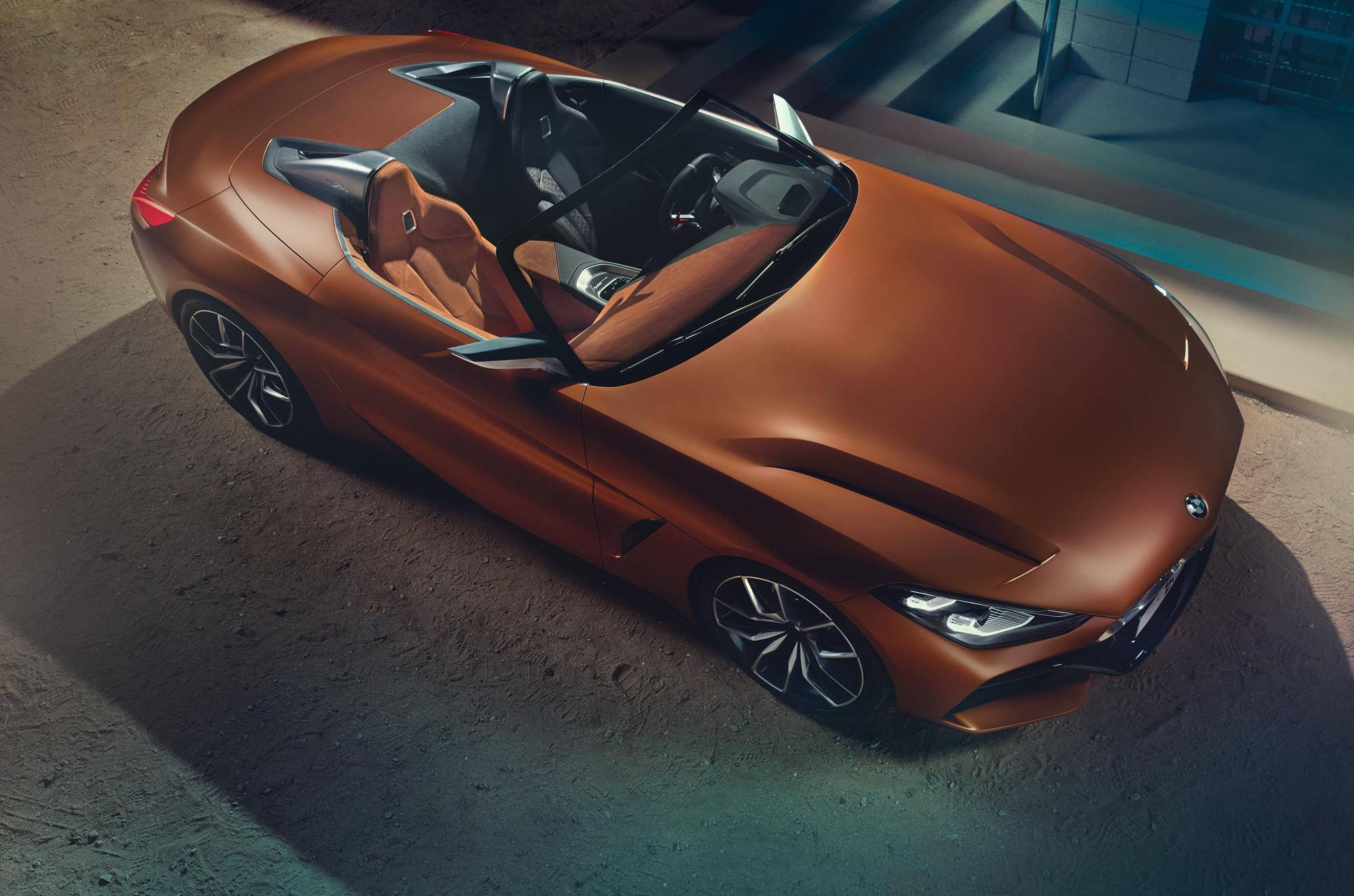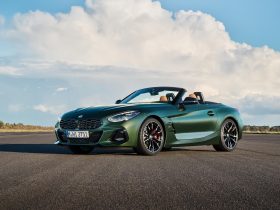BMW has introduced the M3 Sedan. Below the photo gallery are some key details about the car. The car, along with its M4 Coupe brother, will debut at the North American International Auto Show in Detroit this year.
Featuring a return to the inline-6 engine format made famous by BMW M, the all-new, 3.0-liter BMW M3 engine is approximately 10 kilograms lighter than its V-8 predecessor and packs an even stronger punch. With 425 horsepower from 5,500 – 7,300 rpm, 406 lb-ft of torque from 1,850 – 5,500 rpm, and capable of 0-60mph in 3.9 seconds when equipped with the M-DCT transmission (4.1 seconds with standard 6-speed manual).
“Four generations of the BMW M3 have blended motor sport genes and uncompromised everyday usability within an emotionally rich overall concept,” explains Dr Friedrich Nitschke, President BMW M GmbH. “The BMW M3 Sedan and BMW M4 Coupe represent an ongoing commitment to this philosophy. The engine is the heart of every M model, and the new turbocharged six-cylinder unit fitted in the two new cars combines the virtues of a high-revving naturally aspirated unit with the strengths of turbocharger technology. A committed lightweight design concept produces a weight saving of around 80 kilograms over the outgoing M3. The BMW M3 and BMW M4 take motor sport technology from the track to the road, and thousands of laps of the legendary Nürburgring Nordschleife – the world’s most exacting race track – have readied the new models for that transition. Meticulous and passion-fuelled development work has underpinned the creation of two high-performance sports cars that set new standards in terms of overall concept, precision and agility.”
From the Press Release:
Numerous aerodynamics measures integrated into all areas of the body.
The aerodynamics concept of BMW M GmbH models has always been one of the key elements in their development. The engineers need to channel the air around the car to create the best possible platform for dynamic excellence, while also ensuring the engine, powertrain and brakes receive the requisite cooling even when operating under heavy loads on the race track.
Details such as the powerfully formed front apron, smooth underbody and clearly defined Gurney spoiler at the rear of the M3 Sedan (or integrated spoiler lip at the rear of the BMW M4 Coupe) reduce lift by an equal degree at the front and rear axle and produce optimum handling attributes. “The way in which we channel the inflowing air through the engine oil cooler creates a Venturi effect, which reduces front axle lift and, in so doing, improves the steering,” explains Albert Biermann, Head of Development BMW M GmbH. Elements like the Air Curtain and M gills with integrated Air Breather rearwards of the front wheels minimize turbulence in the front wheel arches. Together with the aerodynamically optimized exterior mirrors in twin-stalk style, they are also highly distinctive design features of the BMW M3 Sedan and BMW M4 Coupe and help reduce drag. These examples underline in familiar fashion the success of M engineers in reconciling the requirements of everyday use with the demands of action on the race track.
Sophisticated cooling concept for maximum performance.
The exceptional performance potential of the BMW M3 Sedan and BMW M4 Coupe places extremely exacting demands on temperature management in the engine and peripheral assemblies. In order to ensure optimum operating temperatures in everyday use, on short journeys around town and out on the race track, the BMW M GmbH engineers have developed an extremely effective cooling system. For example, alongside the two ultra-dynamic turbocharger units, the air intake system of the six-cylinder engine also includes an indirect intercooler, maximizing charge pressure and engine output. As well as a main radiator, the track-ready cooling concept also comprises a water cooler repositioned to the side for the high- and low-temperature water circuits, and the engine and transmission oil (if the M Double Clutch Transmission is specified). These ensure a consistent temperature balance and therefore high performance on the track as well as the road. An additional electric coolant pump cools the turbocharger bearing mounts when the car is stationary.
6-speed manual gearbox with throttle blipping.
The engine’s power is transferred to the road via a standard six-speed manual gearbox with robust double-plate clutch. This unit is considerably more compact than its predecessor and 26.4 lbs lighter. As a means of increasing shift comfort, the manual gearbox uses innovative new carbon friction linings in its synchronizer rings. Dry sump lubrication provides an efficient supply of oil to all parts of the engine. The gearbox blips the throttle on downshifts – previously a feature reserved for the M Double Clutch Transmission. This engagement speed control function improves the smoothness of the transmission, helps to enhance stability and was originally developed by motor sport engineers.
7-speed M Double Clutch Transmission with Drivelogic with Launch Control.
The third generation of the M-DCT sees the M engineers once again setting the benchmark in terms of power and race track capability without having to compromise on everyday usability. The optional 7-speed M Double Clutch Transmission with Drivelogic prompts the new high-revving turbocharged engine into emotionally impressive feats. As well as changing gear automatically, in manual mode the transmission enables ultra-fast gear changes with no interruption in the flow of power. The integrated Launch Control function ensures optimum sprinting performance off the line, producing acceleration figures that would be out of range with the manual gearbox. Stability Clutch Control opens the clutch when the car is understeering to bring it back into line. And M-DCT also includes functions like the Drivelogic modes that can be selected by the driver to give the BMW M3 and BMW M4 more comfortable, more economy-focused or even sportier characteristics. The additional seventh gear over the manual gearbox allows longer gear ratios – and delivers the efficiency gains you would expect as a result.
The properties of the extremely light yet impressively durable material CFRP have allowed the engineers to follow a fundamentally new approach in the manufacture of the drive shaft. Made from CFRP, this component feeds the engine’s torque from the gearbox to the rear differential and works under extremely heavy loads – especially in high-performance vehicles. “The impressive stiffness and low weight of the CFRP tubing allow the drive shaft to be constructed as a single-piece unit with no center bearing. As well as a weight saving of 40 percent over its predecessor, we have achieved a reduction in rotating masses and therefore improved drivetrain dynamics,” explains Albert Biermann.
Even more accomplished rear-wheel drive with Active M Differential.
Among the other components that add fresh polish to the dynamic repertoire of the BMW M3 Sedan and BMW M4 Coupe are the hollow lightweight output shafts of the rear differential and the Active M Differential, which uses an electronically controlled multi-plate limited-slip differential to optimize traction and directional stability. The multi-plate limited-slip differential works with extremely high precision and speed. Its control unit links up with the DSC (Dynamic Stability Control) system and also takes into account the position of the accelerator pedal, the rotational speed of the wheels and the car’s yaw rate. Every driving situation is therefore precisely analyzed and an impending loss of traction on one side of the car identified at an early stage. The degree of lock – which may be anywhere between 0 and 100 percent – is adjusted as required within a fraction of a second, enabling wheel spin to be prevented on slippery surfaces, in instances where the right and left rear wheel have widely differing friction coefficients, in tight bends and when changing direction with particular vigor. Optimizing traction in this way also provides unbeatable driving stability in challenging conditions and allows impressively dynamic acceleration out of corners.
M Dynamic Mode – a sub function of the Dynamic Stability Control (DSC) system – quenches the thirst of enthusiastic drivers for keen dynamics. While DSC intervenes as required to counteract understeer and oversteer, M Dynamic Mode allows greater wheel slip and therefore easy drifting. Owners with a taste for sporty and dynamic driving will appreciate this breadth to the cars’ handling, although DSC will still step in if the car ventures over the limits – unless it is switched off completely. Whichever setting the driver chooses, he or she remains responsible for the car’s stability.
Aluminum suspension elements ensure sharper dynamics.
The core expertise of BMW M GmbH resides in developing M cars that offer impressive steering precision, on-the-limit adjustability, agility and driving feeling, together with unbeatable traction and outstanding directional stability – all without neglecting everyday usability. In order to achieve these aims with the significantly increased performance capability of the new BMW M3 Sedan and new BMW M4 Coupe, the axles of the outgoing BMW M3 have been redesigned with painstaking attention to detail.
Here again, low weight and a high level of rigidity for the axle systems are essential ingredients in ensuring the cars provide an ultra-dynamic driving experience. In the double-joint spring strut front axle alone, the use of a lightweight aluminum construction for components such as control arms, wheel carriers and axle subframes saves five kilograms over a conventional steel design. Play-free ball joints and elastomeric bearings developed specially for the BMW M3 Sedan and BMW M4 Coupe ensure an optimum and direct transfer of forces both laterally and longitudinally. An aluminum stiffening plate, CFRP front strut brace and additional bolted joints between the axle subframe and the body structure all help to increase the rigidity of the front end.
Also lighter than the construction in the outgoing BMW M3 is the new five-link rear axle. All the control arms and wheel carriers are manufactured using forged aluminum, which reduces the unsprung masses of the wheel-locating components by around three kilograms compared with the previous model generation. The rigid connection between the rear axle subframe and the body – without the use of elastic rubber elements – is borrowed from motor sport and serves to further improve wheel location and therefore directional stability. “The double-elastic mounting for the rear differential within the rear axle subframe – which is bolted to the body structure – has allowed us to achieve a new level of driving precision, but without neglecting comfort,” says Albert Biermann, citing another example of the perfect symbiosis of pure-bred motor sport technology and excellent everyday usability.
The development of the tires for the cars was incorporated into the construction process for the axles from the outset. For high-performance sports cars like the BMW M3 Sedan and BMW M4 Coupe, in particular, steering feel and precision are the foremost considerations in the development of tires for the front axle, alongside lateral stability and braking forces. At the rear axle, meanwhile, traction, lateral stability and directional stability take center stage. For this reason, both cars will leave the factory on low-weight 18-inch forged wheels (front axle: 9 J x 18, rear axle: 10 J x 18) with mixed-size tires (front axle: 255 mm, rear axle: 275 mm). 19-inch wheels and tires are available as an option. The specially developed forged wheels make a significant contribution to the reduction in the cars’ unsprung masses and, in turn, to the optimization of dynamic qualities and efficiency. The experienced M engineers have taken great care to ensure all the components between the steering wheel and tires work together harmoniously and therefore provide maximum driving precision and lateral stability, along with good ride comfort.
Unique Electric Power Steering with three settings.
The electromechanical steering system in the new BMW M3 Sedan and new BMW M4 Coupe represents a new development from BMW M GmbH and the critical component in the link between driver and car. It offers the gifts of direct steering feeling and precise feedback. The integrated Servotronic function electronically adjusts the level of steering assistance according to the car’s speed, providing optimum steering characteristics at all speeds. The steering for the BMW M3 Sedan and BMW M4 Coupe also offers the driver three settings as standard, which can be selected at the touch of a button. COMFORT, SPORT and SPORT+ modes allow the level of steering assistance to be adapted to suit the situation at hand and the driver’s personal tastes.
“Together, the rigid front and rear structures, precise axle kinematics and an impressively responsive electromechanical power steering system help to deliver the outstanding steering and handling characteristics of the BMW M3 Sedan and BMW M4 Coupe,” sums up Biermann.
The optional Adaptive M suspension likewise comes with COMFORT, SPORT and SPORT+ modes, enabling the driver to choose between a more comfortable damper setting for urban driving, for example, a stiffer set-up for dynamic driving on country roads, and a third option that minimizes body movements and maximizes dynamic performance for use on the track.
With their supreme dynamic attributes in mind, the BMW M3 Sedan and BMW M4 Coupe also come as standard with BMW M compound brakes boasting impressive feel, outstanding stopping power and high resistance to fade. Far lighter than conventional equivalents, these brakes contribute to a substantial reduction in unsprung masses and therefore help to enhance dynamic performance. Even lighter BMW M carbon ceramic brakes can also be specified as an option, their further optimized performance attributes equipping them even more effectively for track use and giving them even greater durability.
The new inline-6 M engine: High-revving, turbocharged unit combines the best of both worlds.
The new BMW M3 Sedan and new BMW M4 Coupe from BMW M GmbH see a return to a six-in-line engine configuration, as used on the second and third generations of this iconic sports car. “When developing a new model we first think about what requirements the vehicle will be expected to meet, and then decide which concepts and technologies will best meet these goals,” says Albert Biermann. The new turbocharged engine combines the best of both worlds – reaching a maximum 7,600 rpm, it is unusually high-revving for a turbocharged engine, resulting in linear power delivery over a wide engine speed range and a soulful engine note, while M TwinPower Turbo technology ensures that peak torque is on top over a broad rpm range. A further hallmark of this engine is its outstanding efficiency.
The new engine sees a slight power upgrade over the previous V-8 to 425 hp, which is delivered between 5,500 and 7,300 rpm. Peak torque has been increased by roughly 40 percent to 406 lb-ft, and is maintained over a very wide rev band (1,850–5,500 rpm). The standard sprint from zero to 60 mph takes the new BMW M3 Sedan and new BMW M4 Coupe 4.1 seconds respectively. Equipped with the 7-speed M Double Clutch Transmission, this number even falls to 3.9 seconds. Top speed is 250 km/h / 155 mph (electronically limited), The new engine also boasts excellent fuel efficiency: the BMW M3 Sedan and BMW M4 Coupe achieve consumption nearly 25 percent better than the previous model’s figures. Regulated pollutant emissions are EU6-compliant.
Instantaneous response, courtesy of M TwinPower Turbo technology.
The M TwinPower Turbo technology comprises two fast-responding mono-scroll turbochargers, High Precision Direct Petrol Injection, Valvetronic variable valve timing and Double-VANOS continuously variable camshaft timing. Valvetronic and Double-VANOS work in tandem to seamlessly control intake valve lift. The result is smooth and efficient power delivery, very sharp response and reduced fuel consumption and emissions.
The six-cylinder engine features a closed-deck crankcase design which is very rigid and allows cylinder pressures to be increased for improved power output. And instead of liners, the cylinder bores feature a twin-wire arc-sprayed coating, which results in a significant reduction in engine weight.
A further technical highlight is the forged, torsionally rigid crankshaft which, as well as providing increased torque-carrying capacity, is also lighter in weight. This significantly reduces rotating masses, resulting in improved throttle response and acceleration.
Track-ready engine oil supply system for outstanding performance.
On the track, the exceptional driving dynamics of the BMW M3 Sedan and BMW M4 Coupe place extra demands on the engine oil supply system, whose design reflects the extensive motor sport experience of BMW M GmbH. The low-weight magnesium oil sump, for example, features a special cover to limit movement of the oil under the effects of strong dynamic lateral acceleration. Under extreme longitudinal acceleration and deceleration, an oil extraction pump and a sophisticated oil return system situated close to the turbocharger likewise help to maintain stable oil circulation. Oil is therefore supplied continuously to all engine components in all driving situations – whether in everyday motoring or during hard driving on the track.
An engine sound in keeping with the motor sport attributes of the BMW M3 and BMW M4 is provided by an innovative flap arrangement in the twin-pipe exhaust system. The electrically controlled flaps just before the rear silencer minimize exhaust back-pressure and produce a BMW M sound which is striking and unmistakable over the entire engine speed range, as well as giving precise feedback on engine load. The different selectable drive modes, which offer drivers a choice of preconfigured, perfectly balanced vehicle set-ups, also feature different engine sound profiles.
Lightweight design across the board: Shedding weight in all the right places.
Intelligent lightweight design was a top priority in the development of the BMW M3 and BMW M4. The goal was to minimize curb weight in order to give both models outstanding driving dynamics and exemplary efficiency. These measures have delivered impressive results, giving the BMW M4 Coupe a DIN curb weight of 1,497 kilograms, around 80 kilograms lighter than a comparably equipped predecessor model – with benefits for driving dynamics and fuel consumption as well.
BMW M3 Sedan also features CFRP roof for the first time.
On the outgoing models, the CFRP roof was confined to the Coupe version. Now, for the first time, the four-door BMW M3 will get this striking design and functional feature as well. The CFRP roof brings weight savings of five kilograms (11 lbs) in the case of the BMW M3 Sedan and more than six kilograms (> 13 lbs) in the case of the BMW M4 Coupe. It also lowers the vehicle’s center of gravity, which has a positive impact on driving dynamics.
Made from aluminum rather than conventional steel, the front side walls and the hood (with power dome) make an important contribution to the models’ lightweight design concept, while at the same time improving axle load distribution.
On the BMW M4 Coupe, the contoured roofline with central channel continues into the trunk lid, emphasizing the even sportier personality of the new model. The newly developed trunk lid not only provides extremely effective tail end styling, its geometry is at the same time precisely tailored for optimized aerodynamics, while the use of carbon fiber and plastics makes for additional weight savings.
The new BMW M3 Sedan and new BMW M4 Coupe also feature a CFRP propeller shaft. The high rigidity and low weight of the CFRP tube mean that the propeller shaft can be produced as a single-piece component, without a center bearing. This achieves weight savings of 40 percent over the previous model and a reduction in rotating masses, which in turn results in more dynamic powertrain response.
The CFRP strut brace in the engine compartment is a further example of how all weight-saving measures on these vehicles have also been tailored to the improvement of driving dynamics. Weighing only 1.5 kilograms (3.3 lbs), the strut brace offers superior rigidity to a comparable aluminum component and at the same time plays a key part in the excellent steering response and precision of both vehicles.
The use of carbon in these models is a reminder that BMW is a global leader in high-strength, lightweight CFRP construction, and that it was BMW who brought out the first mass-production vehicle with a body consisting entirely of this material – the innovative BMW i3.
























